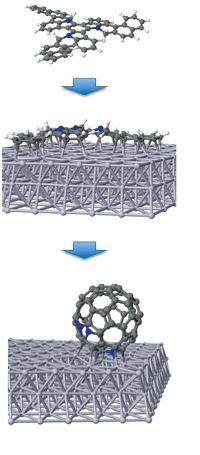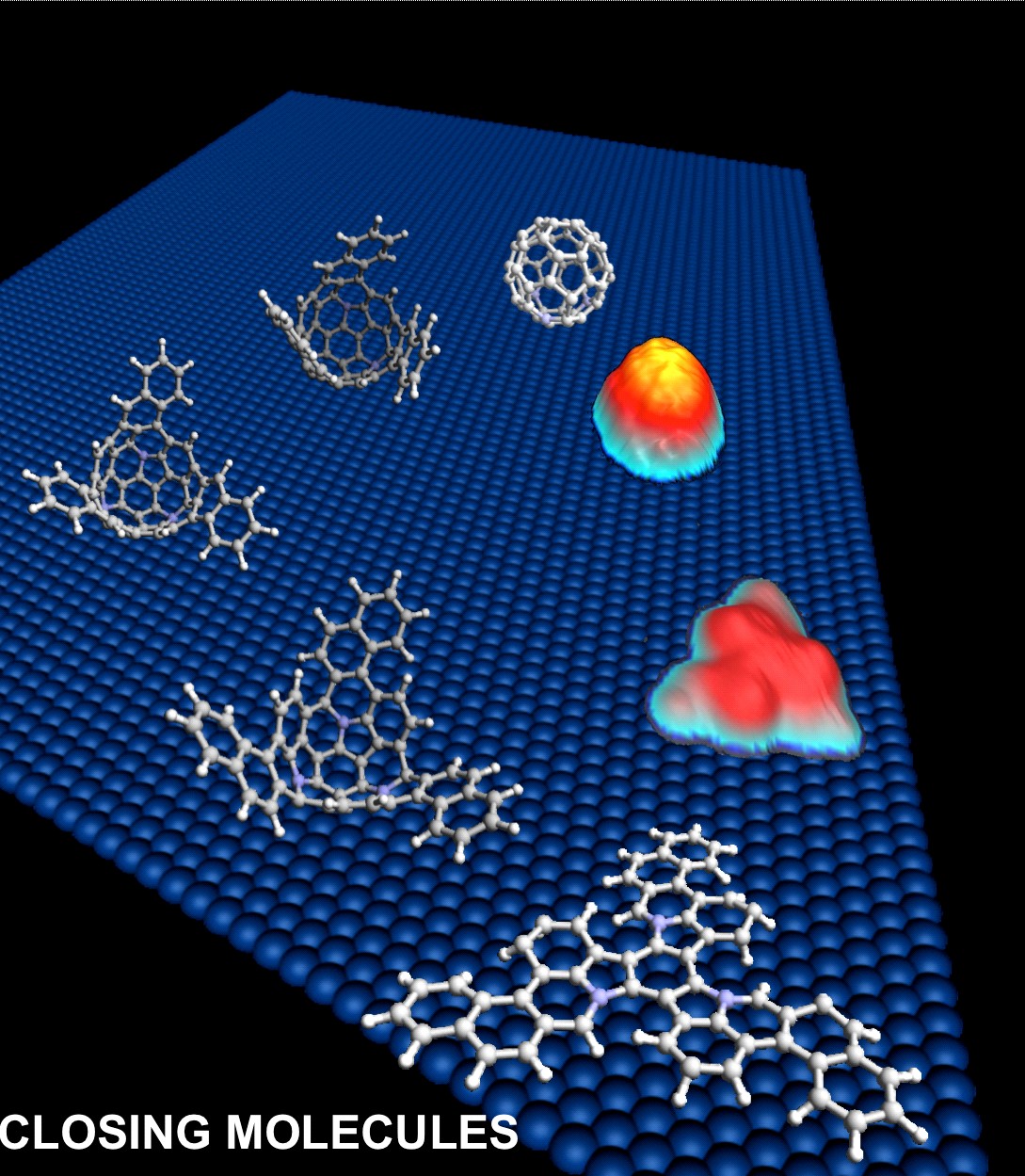SPM-TH
Scanning Probe Microscopy Theory & Nanomechanics GroupForces and Transport in Nanostructures
Research Highlights
Fullerenes "a la carte": Playing Origami at the nanoscale

Fig. 1 Illustration of the different steps in the folding and closing process. (a) Structure of the planar precursor C57H33N3. (b) The molecule is adsorbed at room temperatura on a platinum surface. (c) Structure of the heterofullerene C57N3 formed after\ inducing the dehydrogenation and folding by heating at 477 C (750 K). Grey balls represent carbón atoms, white ones the hydrogens, and blue balls correspo\ nd to nitrogen atoms.

Fig. 2 Graphical image combining the molecular structures at different stages of the process with the STM images of the planar precursor C57H33N3 adsorbed on the Pt surface and the resulting clo\ sed fullerene C57N3.
Fullerenes, molecules formed by 60 carbon atoms and the shape of a soccer ball, represent one of the stable forms of carbon, together with diamond and graphite. Since their discovery in 1985, numerous nanotechnology applications based on their particular mechanical and electronic properties have been proposed. Many of these applications rest on the possibility to create small modifications of the basic molecule, like the substitution of certain carbon atoms by other chemical species (heterofullerenes) or their incorporation inside the fullerene cage (endofullerenes). The great stability of the tridimensional structure has prevented so far the formation of these molecular variants.
In a recent paper published in Nature, a multidisciplinary team formed by researchers of the Institute of Materials Science of Madrid (ICMM, CSIC), the Center for Astrobiology (CAB, CSIC-INTA), the Catalan Institute of Chemical Research (ICIQ) and the Universidad Autónoma de Madrid (UAM), have developed a new method for the controlled synthesis of closed heterofullerenes from planar precursors.
The mechanism is equivalent to play "origami" at the molecular scale. We take advantage of the numerous techniques for substitution and addition of functional groups in planar aromatic molecules to synthesize a planar precursor with the right composition and topology (a Polyciclic Aromatic Hydrocarbons, PAH). This molecule can fold into itself to form the curved, tridimensional structure we are looking for. The secret to trigger the process is the use of the catalytic properties of a platinum surface for inducing spontaneous dehydrogenation of the precursor molecule. The tendency to saturate the resulting dangling bonds induces the folding and closing (cyclization) of the structure.
The whole process has been visualized by STM (Scanning Tunnelling Microscopy), one of the basic tools in Nanotechnology to image and manipulate matter. Quantum Mechanical calculations, combined with the results from STM and other surface science techniques, have allowed us to understand the mechanism at the atomic scale.
The high efficiency of this process paves the way for the controlled synthesis of a whole new family of fullerene derivatives. In our work, we have made use of this process to synthesize for the first time the triazafullerene C57N3, that can play an important role in molecular electronics. Additionally, cyclisation on a controlled flux of different guests could open the door to the encapsulation of atoms or small molecules to form endohedral fullerenes, species not readily available nowadays by other methods in spite of their promising potential applications.
This work demonstrates the importance of a multidisciplinary approach to make a significant progress in Nanotechnology. Its development has required the contribution of large group of scientists that have been directed by Berta Gomez-Lor (ICMM-CSIC) and Antonio Echavarren (ICIQ) in the chemical synthesis, by Rubén Pérez (UAM) in the theoretical simulations, and by Jose A. Martín-Gago (ICMM-CSIC,CAB) in the experimental characterization and general coordination.
Gonzalo Otero1, Giulio Biddau2, Carlos Sánchez-Sánchez1, Renaud Caillard1, María F. López1, Celia Rogero3, F. Javier Palomares1, Noemí Cabello4, Miguel A. Basanta2, José Ortega2, Javier Méndez1, Antonio M. Echavarren4, Rubén Pérez2, Berta Gómez-Lor1 & José A. Martín-Gago1,3.
Fullerenes from aromatic precursors by surface-catalysed cyclodehydrogenation
Nature 454 , 865-868 (2008).
(DOI link)
(pdf)
1 Instituto de Ciencia de Materiales de Madrid (CSIC), Cantoblanco, 28049 Madrid, Spain.
2 Departamento de Física Teórica de la Materia Condensada, Universidad Autónoma de Madrid, 28049 Madrid, Spain.
3 Centro de Astrobiología (CSIC-INTA), Carretera de Torrejón a Ajalvir, km 4, 28850 Torrejón de Ardoz, Madrid, Spain.
4 Institute of Chemical Research of Catalonia (ICIQ), Avinguda Paisos Catalans 16, 43007 Tarragona, Spain.